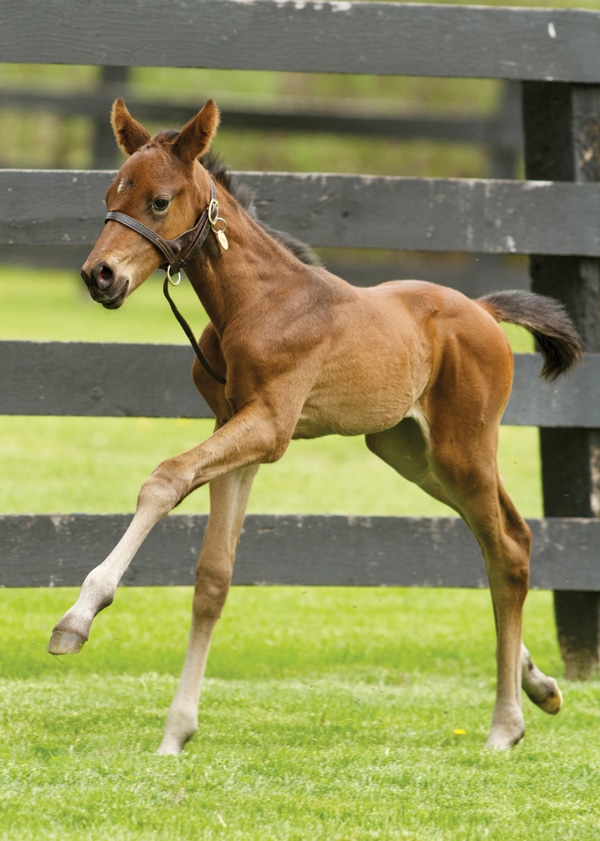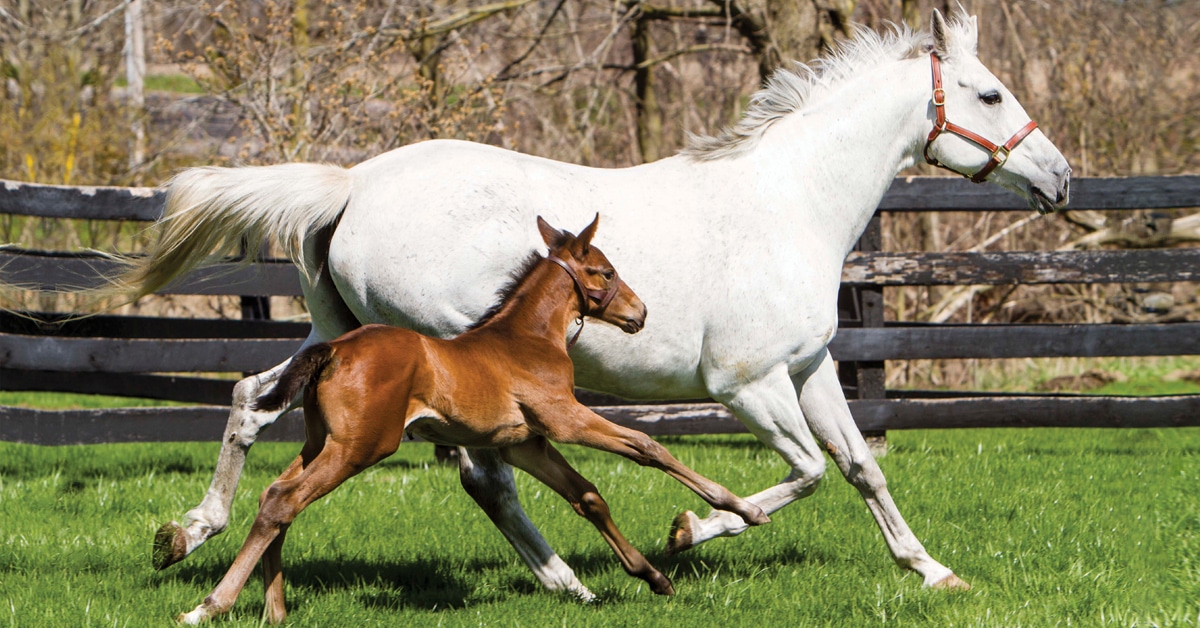By design, a healthy foal is essentially born to hit the ground running. His little legs are purpose-made in the womb with strong bones so he can gallop the heck out of Dodge shortly after birth should a predator come looking for a snack.
The leg bones he’s born with, although tough, consist mainly of cartilage and only about 17 per cent bone mineral content (BMC). But, in his first year of life, skeletal development occurs rapidly. By the time he’s six months old, BMC is already up to 68 per cent and when he’s a year old, it’s at 76 per cent. Meanwhile, industry estimates suggest an average year-old thoroughbred is at 94 per cent of his mature height and 46 per cent of his mature weight. Then, however, unlike height and weight, skeletal sprouting slows, and maximum BMC isn’t usually reached until age six. Nevertheless, a youngster’s bones are still growing. In fact, bone constantly changes through modelling and remodelling.
“The function of bone modelling is to form or resorb bone to alter and maintain bone shape during growth. Modelling adapts bone to better endure the strains it experiences and is most active during growth and development of the immature animal,” explain Michigan State University researchers Alyssa Logan and Brian Nielsen in their study: Training Young Horses: The Science behind the Benefits.
Released last February in the scientific journal Animals, the paper addresses the controversy behind entering horses into race training at two years of age by analyzing 65 previous research studies. Logan and Nielsen write that the adult skeleton undergoes some modelling but not as frequently as in young horses. “For this reason, while horses are growing, their skeletal strength is highly influenced by the strains their bones undergo through daily use and exercise.”
Although it remains controversial, there’s scientific evidence that encouraging bone to change its shape and material properties in response to mechanical strain or load (i.e. exercise) by allowing juveniles to enter race training and racing could be the better way to go than waiting until a horse’s skeleton is fully formed. This follows numerous human studies that reveal the bones of children are particularly responsive to developing strength and mass and that these qualities can be “banked” into adulthood.
Some researchers even suggest movement and exercise – whether free play during pasture turnout or even more regulated activity – in horses as young as foals and weanlings, could actually set their bones up to be more resilient into adulthood, potentially leading to longer, more productive careers with fewer breakdowns.

“I very strongly believe that horses need to be out in big fields,” said Everatt-Meeuse. “We can’t expect them to be athletes if they’re not developed properly with natural bone density…” (Dave Landry photo)
Focus On Free Play
Children running, jumping, climbing, skipping, hopping, sliding and other such energy-intensive activities are engaging in locomotor play, which helps them learn fundamental movement skills and supports physical development. The same is happening in a paddock, field or other open space when a foal takes a rollicking gallop away from mama or weanlings get into a rough-and-tumble scuffle. This innate, spontaneous play occurs early in a foal’s life and is as valuable to young equines as it is to kids on the playground, say researchers Chris Rogers and Keren Dittmer of Massey University in New Zealand.
“The intensity and vigour of locomotor play increases with age and this, in turn, provides cumulative increases in the loads the musculoskeletal system experiences,” they state in their 2019 paper: Does Juvenile Play Programme the Equine Musculoskeletal System? also published in Animals. They go on to explain their review explored the interaction between play and bone development at a molecular through to a whole-animal level. They applied their understanding using the mechanostat theorem, which assumes that bone tissue attempts to maintain strain within a certain physiological range. Bone changes in response to loads above this range. Loads below result in remodelling.
“These progressive cumulative loading cycles (bouts of locomotor play), in both the timing and magnitude, reflect the microstrain required to stimulate bone development based on the mechanostat theorem. Data from the published literature were presented to provide empirical support for this hypothesis. Thus, spontaneous locomotor play may be vital to ensure optimal bone development in the horse,” wrote Rogers and Dittmer. They added, “Modern production [commercial breeding] systems need to provide appropriate opportunities for foals to perform spontaneous locomotor play to optimise bone development and reduce the risk of future musculoskeletal injury later in life.”
Arika Everatt-Meeuse of Shannondoe Farm agrees. Originally based solely out of St. Thomas ON, the breeding and sales prep operation expanded 16 years ago to encompass a 150-acre satellite operation in Paris, KY – Colton Springs Farm. One of the main benefits of the acquisition was allowing the youngsters to frolic on massive rolling pastures and graze limestone-rich grass.
“I very strongly believe that horses need to be out in big fields,” said Everatt-Meeuse. “We can’t expect them to be athletes if they’re not developed properly with natural bone density. You can’t raise them on a postage stamp. You certainly can’t lock them up and raise them in stalls and treat them like halter horses. They have to be out and moving around. That’s what we’re raising them for.”
A 1999 study out of the Netherlands investigated the effect of stalling on bone development in Warmblood foals. One group of 14 foals was confined to a box stall from birth to five months of age. Another group was kept in similar box stalls but received daily exercise through an increasing number of gallop sprints from the age of one week. A third group was on pasture 24/7. At five months, eight foals from each group were randomly selected and euthanized, while the remaining 19 had pasture access for six months and were euthanized at 11 months. Analysis showed confinement resulted in retardation of normal bone development, which was compensated for when the foals were allowed to exercise.
Exercise Plan
Not only is free play beneficial for foals and weanlings, but appropriate levels of physical conditioning could also be appropriate in building strong bones for life.
As early as 2004, Nielsen from Michigan State was involved in research that suggested stalled weanlings given short periods of exercise – sprints in a fenced grass alleyway, turned loose in a small pen and allowed to run back down the alley – increased bone mineral content and altered bone geometry in comparison to those kept in small paddocks over an eight-week period, indicating they may be better adapted for training than those beginning at a later age.
Currently, Annette McCoy, assistant professor of equine surgery at the University of Illinois at Urbana- Champaign College of Veterinary Medicine (UIUC), and her colleagues are in the process of evaluating what impact a “moderately strenuous exercise plan” might have on bone development in foals. More specifically, the study will determine whether doing mile-long trot sets could protect foals from suffering repetitive stress-related lower-leg fractures later in life. (Most fractures occur between the ages of two and 10 years of age.)
The team is examining 12 standardbred pre-weaned foals kept on the UIUC farm beginning when they are eight weeks old. A baseline computed tomography (CT) exam will create a three-dimensional picture to measure bone density and volume on the forelegs of each foal. Half of the group will complete an eight-week exercise plan where they trot rapidly over 1,500 yards following their dam, once a day, five days per week. The other half will be a non-exercised control group.
At both 16 weeks and a year old, all the foals’ forelegs will be scanned again for comparison. A computer model will predict the effects of exercise interventions on bone properties. The hope is that the project, which is funded by the Morris Animal Foundation, will eventually lead to development of exercise programs that will, long term, result in fewer injuries.
In the real world, Everatt-Meeuse also puts horses she feels need a growth spurt on a walker or she often does long trotting while ponying. “We’re putting some pressure on that bone development,” she explained. “It’s like a body builder going to the gym. We’re taking it up a notch. Whereas running around in the field, they’ve just been doing their thing. We’re now adding exercise.”
She slowly builds them up to the desired level of activity. “It’s amazing when you put on that pressure, you get development. Whatever it is I’m trying to accomplish, I’ve never seen it go backwards.”


